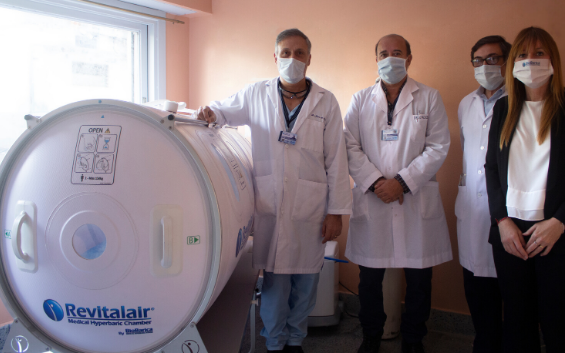With a new medical device, the medical institution will carry out a research protocol that aims to study whether hyperbaric oxygenation treatment reduces recovery times in patients affected with COVID-19 and how it would impact the need for mechanical ventilation (respirators)
From this week, the Central Hospital of SanIsidro, Buenos Aires, has a Hyperbaric Medicine unit in which it will develop a protocol to analyze if Hyperbaric Oxygen Therapy significantly reduces the progression of hypoxemia (low blood oxygen level), respiratory disease, respirator requirement, and recovery times in COVID-19 infected patients.
The protocol will be developed with a Revitalair® 430 Hyperbaric Chamber that was donated by BioBarica. This research has the endorsement of the Argentine Association of Hyperbaric Medicine and Research (AAMHEI) and the supervision of its president, Dr. Mariana Cannellotto.
So far, there have not been reported cases of COVID-19 treated with hyperbaric oxygenation in Argentina. This is a practice that is already documented in other countries, so this protocol from theCentral Hospital of San Isidro sets a very important precedent in research on possible treatments for the disease.
How could Hyperbaric Chamber Therapy help patients with COVID-19?
COVID-19 can cause progressive respiratory failure or complications such as heart failure. In most of these cases, there are used respirators, but it is a complicated decision when the resource is limited for the high demand of this pandemic with great transmissibility. The benefit-risk assessment is constant and depends on different factors. It is essential to know and control the generated immune response and the inflammatory cascade that triggers the Coronavirus for the control and elimination of the infection.
Hyperbaric Treatment produces an increase in pulmonary oxygenation and increases the immune response. Given the emergence of patients with COVID-19, it could be used in infected patients with hypoxemic respiratory failure who do not have pulmonary contraindications. It can contribute to recovering the acute hypoxic phase (without oxygen) of the disease, reducing the inflammatory phase, promoting recovery, and speeding upthe times for the release of hospital beds.
During the first trimester of the year, in a hospital in Wuhan, Dr. Zhong Xiaoling treated 5 patients infected with COVID-19in a Hyperbaric Chamber. After the first session, he reported that dyspnea and chest pain were reduced. After the second, the respiratory rate decreased and the difficulty in breathing eased more slowly. From the fifth day of treatment, arterial oxygen values were significantly recovered. Lung improvement was evident and CT scans showed lower levels of tissue inflammation.

